Secrets of planting and growing roses from a bouquet
Planting beautiful flowers from a presented bouquet is a feasible task, but not every rose can be used for reproduction. Getting strong seedlings will require knowledge and the utmost care, as roses are susceptible to mistakes in grooming.
Secrets of choice
First of all, you need to decide if the bouquet is suitable for grafting. It will be difficult to determine this without experience. Therefore, we suggest that you familiarize yourself with the recommendations of experienced florists:
- there are more chances to grow strong seedlings from flowers grown by domestic producers: they are zoned and hardened. Roses brought from Holland and other foreign countries are not suitable, because they are treated with gas and various pesticides, which preserve them for a long time. Such flowers will not be able to give good planting material;
- the best result is achieved when planting blanks from recently cut plants. If a rose stays in a room for several days, it will not give good roots;
- for cutting seedlings, roses with a soft stem are used, green or old "wooden" ones take root worse;
- the workpiece must have at least 2 buds;
- it is not recommended to cut seedlings from thick or very thin stems.
Preparing cuttings for planting
Growing a bouquet rose is not much different from grafting a garden rose. The best time to get started is spring. However, bouquets are also given in other seasons - then you will need to organize a school.
Harvesting cuttings:
- Choose a rose with a stem that has just begun to turn brown.
- If the stem is short, cut out a workpiece 150 mm long from the middle part. It should have 2-3 kidneys.
- Cut the upper part at an angle of 90 °. The lower cut is made at an acute angle, so that 10 mm of the trunk remains above the kidney.
- Remove the lower leaves completely, they will be covered in the soil. You can leave 1-2 leaves on top, they will help determine the condition of the seedling. The side branches and foliage will take power from the root system. It is important to grow strong roots at this stage.
Basic methods of cutting roses
Let's move on to the next step. For work, we need to prepare:
- sharp knife;
- only cut cuttings;
- container for planting;
- universal primer for flowers;
- ready-made composition for the development of roots of seedlings "Kornevin", "Heteroauxin".
There are several techniques for cutting roses, each has its own adherents. Therefore, we will analyze each method so that you can choose the most suitable for you.
In water
This is the simplest and least expensive method. We use filtered or well water to soak the cuttings. The tap contains chlorine, so it is not recommended to germinate the roots in it.
Stages of work:
- prepare a container: the cuttings should be immersed in water by 1/3 and not crowded in a saucepan;
- fill in water, add Kornevin solution and put the prepared seedlings in the dishes;
- we remove to a shaded place;
- after 2-3 days we replace the water, while the cuttings are not taken out of the container so as not to damage the roots;
- we change the water according to the indicated scheme within 18-20 days.
After 2 weeks, whitish growths begin to appear on the parts immersed in water, from which the roots break through. After the 3rd week, the seedlings are ready to move to the school. The technique for moving is described in the chapter "Rooting rose cuttings with potatoes". The difference is that the sprouts are planted without potatoes.
Important
This simple technique has one significant drawback: the root system does not receive enough oxygen, so it develops poorly and can rot in water.
In the ground
This method is the most famous and effective. Saplings are rooted in seedlings or greenhouses. In the soil, plants receive nutrition and oxygen, so they quickly lay the root system. We recommend planting each stalk in a separate container, so that when moving into open ground, you do not damage the roots and do not slow down the flowers in development.
It is enough to buy a plastic disposable glass with a volume of half a liter and make several holes in it for water drainage. If it is not possible to organize separate "dwellings" for cuttings, they are planted in boxes at a distance of 60 mm or a little more from each other.
Operating procedure:
- Before filling the soil, we disinfect the containers with potassium permanganate. The darker the solution, the better. At the bottom we put a few expanded clay pebbles for drainage.
- We fill up the purchased soil for flowers or prepare the soil ourselves. To do this, mix 2 parts of sod land with 1 part of sand and soil from the compost pit. Fry the soil on a fire or in the oven, destroying the embryos of pests and diseases. We do not add the soil to the top of the container by 5-7 mm. This backlog will not allow water to pour out when moistened, and will also be needed for a small layer of mulch.
- We compact the soil a little, treat the lower part of the cutting with a growth stimulator.
- We make a groove with a wooden or steel stick and install a handle in it.
- We compact the earth around the seedling, water it and protect it with a bag or covering material.
- We put the seedlings in a place with diffused sunlight. Air temperature - at least + 15 ° C at night.
As soon as the first small sprouts appeared in the axils of the buds, we remove the package and begin to prepare the plant for transplantation into open ground, temper it. To do this, we take out the cuttings outside, first for 15-20 minutes, then gradually increase the time. This is how the seedlings get used to the sun and wind. After the appearance of the first real flower, we recommend fertilizing the seedlings with a ready-made complex fertilizer for flowers with a growth enhancer. Do not forget to water the roses: the ground should always be moist and loose.
We plant the grown seedlings in open ground. To do this, we prepare a bed and relocate the plants according to the scheme given in the next chapter.
In potatoes
For germination, we take potatoes without mechanical damage and traces of disease - one root crop for each cutting.
Then we prepare the tubers and the planting site:
- We wash each potato in water and remove all eyes.
- We process it with potassium permanganate and let it dry.
- This method allows you to plant cuttings directly in the school, therefore we prepare the soil according to the above scheme in a garden bed with little shading and without drafts.
- At a distance of 50-70 mm, we dig holes, 100-150 mm deep.
- At the bottom, we make a filling of the drainage layer from expanded clay or sand, broken brick.
- We fill the hole with soil, in the middle we make a recess according to the size of a potato.
- Watering.
- Cut out a groove in the potato, set the stalk into it to the required depth and place the tuber in the prepared place.
- We fill the planting site with soil, compact it and add a layer of mulch to the hole.
It remains to cover the plants with a mini-greenhouse and grow cuttings with a strong root system into the soil before the autumn transplantation.
In a paper bag
This is not the most popular method, but it may come in handy. In America it is called the "Burrito" method. To work you need old newspapers, a plastic bag, water and cuttings:
- Soak the prepared cuttings for 24 hours in a Heteroauxin solution.
- We put the seedlings on the newspaper.
- Fold the edges and make a paper envelope.
- Water the newspaper well.
- Place the package in a plastic bag and put it away for 2-3 days in a shaded place with a temperature of at least + 15-18 ° C.
- For 18-20 days, we periodically unfold the cuttings, check their condition and moisten the newspaper.
- After the formation of the first roots, we plant roses in the school.
On a temporary bed, we always maintain a well-moistened and loose soil, when the first signs of diseases and pests appear we process the seedlings with means of protection... So we grow cuttings until autumn.
Landing in open ground
For this, we are preparing a landing site. It must meet several requirements:
- partial shade is permissible, but with necessarily sunlight in the morning;
- without drafts and constantly blowing winds;
- on a hill or on a flat flower bed;
- with well-drained, light soil.
Important
It is not recommended to plant plants without preliminary treatment, where roses grew before. Here you will have to fertilize the soil and decontaminate the soil.
Landing order:
- We dig holes, the dimensions of which should exceed the dimensions of the root system by 2-3 times. Depth - 600-700 mm. At the bottom of the hole, lay a layer of broken brick or sand for drainage, thickness - from 80-100 mm.
- Prepare the soil: mix 2 parts of sod soil with 1 part of humus and 1 part of sand.
- Before digging out the cuttings, we water the ground of the school well and only after that we take out the seedlings, otherwise the roots can be easily damaged.
- We examine the seedling and its root system, making sure of their integrity.
- Soak the roots in a manure solution for several hours.
- Pour water into the hole, fill in a little prepared soil so that a small earthen slide forms under the roots.
- Only after that we install the bush, straighten the roots, not allowing them to bend.
- We fill up the earth in small portions, protecting the roots.
- Leave a distance to the top of 50-80 mm and lay the bark of deciduous trees or sawdust for mulching.
The seedlings will begin to take root. Before winter, we must reliably cover them from frost, and in spring strong bushes of roses grown from a bouquet will appear on the site. The operation is quite troublesome, but it allows you to grow new varieties of beautiful flowers at no extra cost. Love your green pets, and a beautiful flower garden will become your pride.
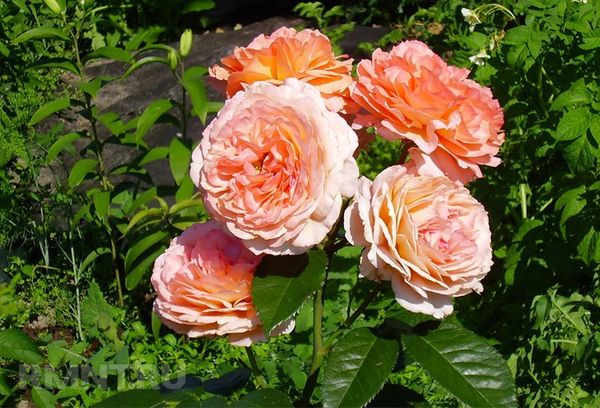
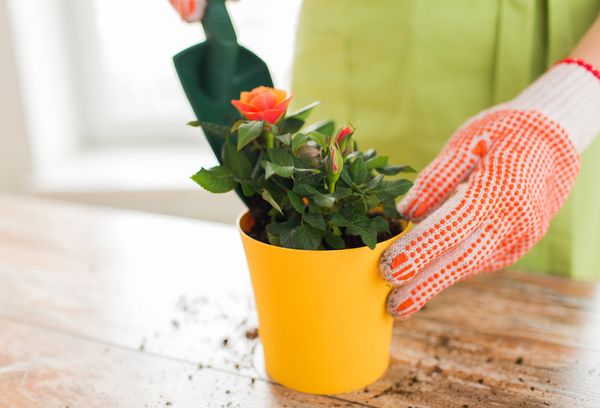
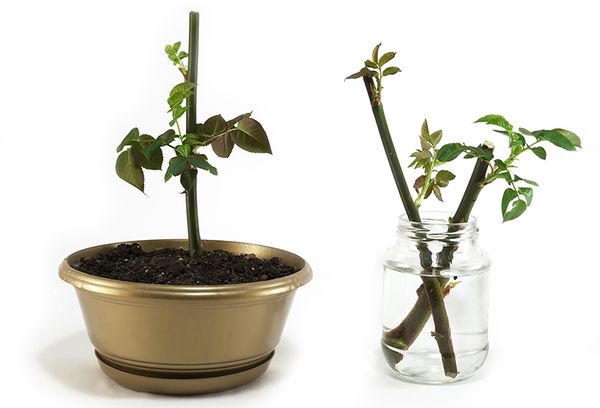
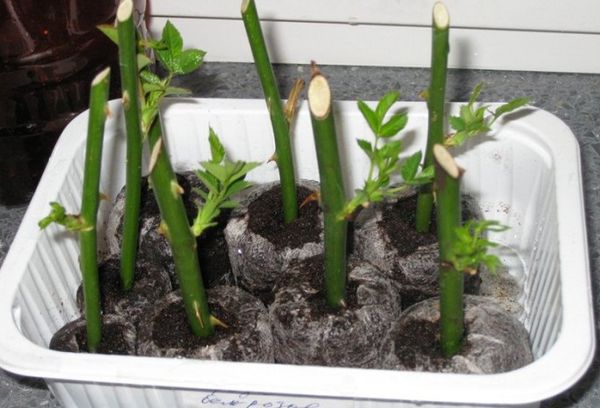
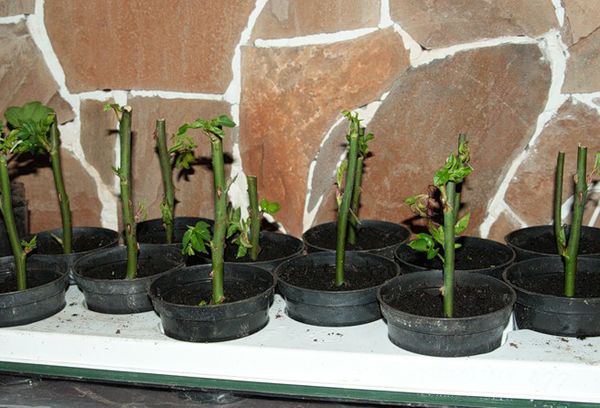
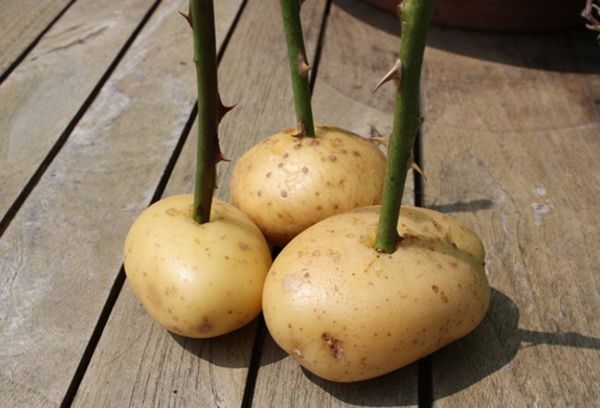
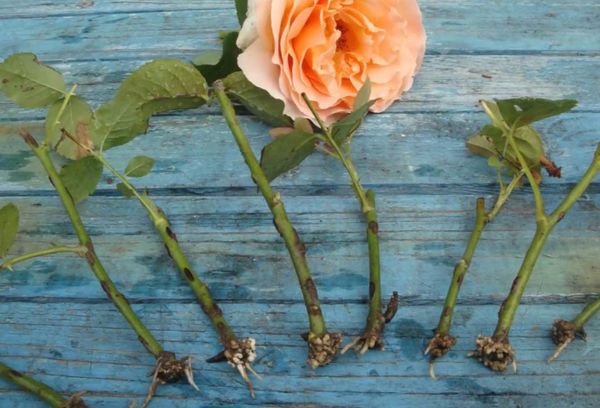
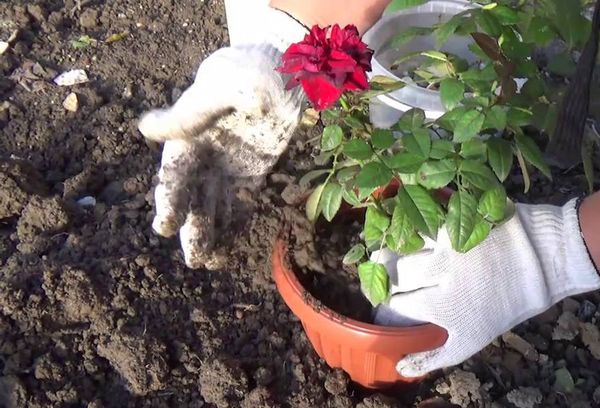
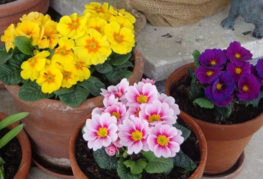

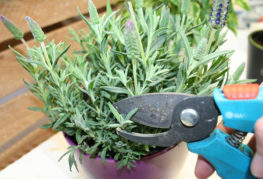

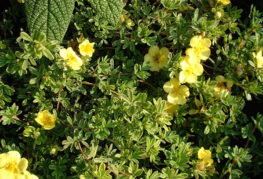
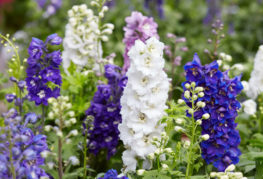
and will be published shortly.